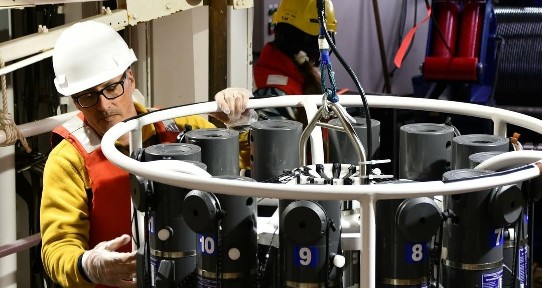Metals, microbes and the health of the Arctic

March 22, 2025 | by Nicole Crozier
Sea-ice, permafrost and glaciers in our polar regions are melting. The news stories that typically accompany that reality often talk of starving polar bears, rising sea levels, walruses losing their homes, and disrupted weather patterns. Less discussed is the impact on the chemical composition of the ocean itself, particularly when it comes to trace element and isotope (TEI) concentrations.
That’s where UVic SEOS professor Jay Cullen comes in. The chemical oceanographer has been studying TEI concentrations in the Arctic for almost 20 years, looking to understand the processes that control the distribution and chemical form of trace elements, their availability to microbes, and how climate change is likely to impact trace element chemistry in the future.
“Over the course of my career, I have witnessed dramatic changes in sea-ice cover in response to regional warming,” says Cullen. “Through careful measurements, we’ve demonstrated that even though the Arctic is far removed from hubs of human industrial activity in the south, it is not immune to anthropogenic contamination.”
Trace metals are elements that are found in very small concentrations in seawater—Cullen is often measuring iron, copper, zinc and silver, among others. While the concentrations may be small, these metals play a large role in the growth of marine microbes, which are themselves a key part of the ocean ecosystem. Photosynthetic marine microbes are one of the world’s largest consumers of carbon dioxide, and help to mitigate climate change through the sequestration of atmospheric carbon dioxide. They also form the base of the marine food web, serving as prey for many other species, who are then preyed upon themselves.
The amount and chemical form of trace metals in seawater can have an impact on the growth of photosynthetic microbes. As essential limiting nutrients, a lack of certain trace metals will prevent growth. At the same time, trace metals are toxins when too abundant.
“While trace metals are not abundant in the ocean, they have impacts that are much greater than their small concentrations might suggest,” says Cullen. “Ultimately, it’s these metals that control the ocean’s ability to take up greenhouse gases and slow climate change.”
Increasingly, human activity is impacting the accumulation and distribution of trace metals in the ocean, both directly and indirectly. Industrial activities, agriculture and the burning of fossil fuels are all leaching heavy metals into the ocean. Natural sources of metals are also changing due to climate change—melting glaciers and sea-ice, the thawing of the permafrost and increased river runoff are all expected to contribute to an increase in trace elements in the Arctic Ocean. Due to Arctic currents, which move Arctic waters from the Beaufort Sea, through the Canadian Arctic Archipelago and Baffin Bay, and into the Labrador Sea, these changes can have local impacts but also cause downstream effects in the North Atlantic.
There is still more work to be done to better understand how changing temperatures, melting glaciers and sea-ice and other consequences of climate change will impact biologically important metals, but these are questions Cullen is working on finding answers for.
“A better understanding of what is happening in our oceans will allow policy makers to make effective plans to moderate and mitigate ongoing human caused climate change and to sustainably manage and steward our marine resources into the future,” says Cullen.

Cullen has recently expanded his work to the Antarctic. In late February, PhD student Tia Anderlini, working under the supervision of Cullen, headed to Antarctica on board the HMCS Margaret Brooke, as part of the first circumnavigation of South America and visit to Antarctica by a Royal Canadian Navy vessel. There, Anderlini is sampling seawater to determine the impact that the melting of tidewater glaciers and coastal erosion may be having on trace metal concentrations along the Antarctic Peninsula and South Shetland Islands, and the implications for biological productivity. This work in the Antarctic will provide a valuable comparison of the processes controlling trace metal distribution in both polar regions.
